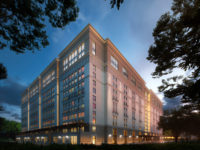First Look: Governors Island














When superstorm Sandy wreaked havoc around New York Harbor, Governors Island was largely spared, in large part because construction of a new park had involved both adding elevation and installing proper drainage. “I’m glad my landscape architect is Dutch,” says Leslie Koch, president of the Trust for Governors Island, referring to Adriaan Geuze, the principal of Rotterdam-based West 8. That firm, chosen in a 2007 competition (as part of a team that included Mathews Nielsen Landscape Architects, Pentagram, Tillotson Design Associates, Diller Scofidio + Renfro, and Rogers Marvel) has been transforming much of the 172-acre island into parkland. Now 30 acres of that park are set to open on Saturday, and the island that weathered Sandy will face the onslaught of public opinion.
Most of the reviews should be glowing. Geuze, best known to Americans for a park overshadowed by Frank Gehry’s New World Symphony building in Miami, has transformed the dot on Manhattan’s exclamation point. Twenty-six buildings (many banal vestiges of a coast guard station) have been leveled, and 2,200 parking spaces have been eliminated; that left lots of open space, much of which is now grass and shrubs. The demolition also created rubble from which Geuze has created hillocks that provide topographic variety, in some cases even blocking views of the Statue of Liberty. “The statue,” Koch explains of the scheme, “isn’t as interesting if you see at all the time.”
Perhaps for the first time since the decision was made to turn the southern part of the island into a park, Governors Island feels cohesive. That’s in part because of new street furniture, including lighting designed by Tillotson and a signage system created by West 8 with Pentagram’s Michael Bierut. The former looks a little futuristic for an island that contains a castle; the latter is more contextual. Plantings are simple—Governors Island doesn’t have the kind of income stream required for High Line-style horticulture—and new bike and pedestrian paths are asphalt, which is less than beautiful but may be the most practical surface. Among the features of the new parkland are hammock groves (hammocks have been an island offering since 2009) and timber playgrounds by West 8 and the German firm Richter Spielgeräte. If there is one mistake, it’s that all of the curbs (some raised to become benches) are made of cast concrete with a depressed pattern of blobby shapes, which Koch says is a Geuze trademark. Perhaps it shouldn’t be. The design is fussy, and the depressions are just deep enough to complicate maintenance. But that’s a quibble. Governors Island is finally a real park.


